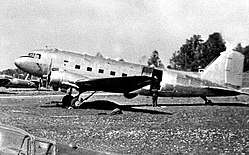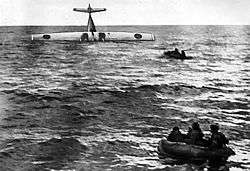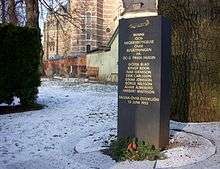Catalina affair
The Catalina affair (Swedish: Catalinaaffären) was a military confrontation and Cold War-era diplomatic crisis in June 1952, in which Soviet Air Force fighter jets shot down two Swedish aircraft over international waters in the Baltic Sea.
 Tp 79 Hugin at F 8 Barkarby in 1951 | |
| Incident | |
|---|---|
| Date | 13 June 1952 |
| Summary | Shot down |
| Site | East of Gotska Sandön 58°23.522′N 20°17.460′E[2] |
| Aircraft | |
| Aircraft type | DC-3A-360 Skytrain |
| Aircraft name | Hugin [3][4] |
| Operator | Swedish Air Force |
| Flight origin | Stockholm Bromma Airport Stockholm, Sweden |
| Destination | Stockholm Bromma Airport |
| Passengers | 0 |
| Crew | 8 |
| Fatalities | 8 |
| Survivors | 0 |
 | |
| Incident | |
|---|---|
| Date | 16 June 1952 |
| Summary | Shot down |
| Site | East of Gotska Sandön |
| Aircraft | |
| Aircraft type | PBY-5 Catalina |
| Operator | Swedish Air Force |
| Flight origin | F 2 Hägernäs[5] near Stockholm, Sweden |
| Destination | F 2 Hägernäs[6] |
| Passengers | 0 |
| Crew | 5 |
| Fatalities | 0 |
The first aircraft to be shot down was an unarmed Swedish Air Force Tp 79, a derivative of the Douglas DC-3, carrying out radio and radar signals intelligence-gathering for the National Defence Radio Establishment (Försvarets radioanstalt, FRA). None of the crew of eight survived.
The second aircraft to be shot down was a Swedish Air Force Tp 47, a Catalina flying boat, involved in the search and rescue operation for the missing DC-3. The Catalina's crew of five were saved.
The Soviet Union publicly denied involvement until its dissolution in 1991. Both aircraft were located in 2003, and the DC-3 was salvaged.
Aircraft and crew
DC-3
The first aircraft involved was a Swedish Air Force Douglas DC-3A-360 Skytrain,[2] a military transport derivative of the DC-3 known in Swedish service as Tp 79. It carried the serial number 79001. In the media coverage following the event, it became known simply as "the DC-3."
The aircraft was manufactured in 1943 with original US serial number 42-5694, and was delivered to USAAF 15th Troop Carrier Squadron (61st Troop Carrier Group). It saw action in northern Africa before being stationed at RAF Barkston Heath. It was flown on 5 February 1946, from Orly Air Base via Hanau Army Airfield to Bromma and was registered as SE-APZ on 18 May 1946 as a civil aircraft to Skandinaviska Aero AB.[7][8]
On 13 June 1952, it disappeared east of the isle of Gotska Sandön while carrying out signals intelligence-gathering operations for FRA.[9] The aircraft was lost with its entire crew of eight in the incident. Three of the eight crew members were military personnel from the Swedish Air Force, and the other five were civilian signals intelligence (SIGINT) operators from the FRA.[10]
Catalina
Three days after the initial incident, on 16 June 1952, two Consolidated PBY-5 Catalina flying boats, known in Swedish service as Tp 47, searched for the DC-3 north of Estonia. One of the aircraft, carrying airframe serial no. 47002,[9] was shot down by Soviet aircraft, but the crew of five ditched near the West German freighter Münsterland and were rescued.[11][12][13]
Aftermath
Sweden maintained for nearly 40 years that the plane was undertaking a navigation training flight.[14] Only after pressure from crewmembers' families[15] did Swedish authorities confirm that the DC-3 was equipped with British equipment and had been conducting surveillance for NATO.[16]
In 1991, General Fyodor Shinkarenko (ru), a colonel in the early 1950s, admitted he had ordered the DC-3 shot down in 1952 by scrambling a MiG-15bis to intercept it.[17]
Recovery
.jpg)
On 10 June 2003, airline captain and former Swedish Air Force pilot, Anders Jallai, and historian Carl Douglas with the Swedish company Marin Mätteknik AB found the remains of the downed DC-3 by using sonar at 126 m (413 ft) depth.[2][16][18][19]
After 52 years, the remains of the DC-3 were lifted to the surface on 19 March 2004. Debris from the area was also recovered by freeze dredging. 200 m3 (7,100 cu ft) of surrounding sediment was frozen, and lifted together with the object on and in it.[20] The wreck was transferred to Muskö naval base for investigation and preservation, and was finally put on display at Swedish Air Force Museum, Linköping on 13 May 2009.[21] A 1:12 scale model of 79001 was loaned to the Air Force Museum on 5 May 2009.[22]
Conclusion

Bullet holes on 79001 showed that the DC-3 was shot down by a MiG-15bis fighter. The exact splashdown time was also determined, as one of the clocks in the cockpit had stopped at 11:28:40 CET.[23] The remains of four of the eight-man crew have been found and positively identified.[24]
See also
- "Whiskey on the rocks"
Notes
- Magnusson, p. 10
- Magnusson 2007, p. 9
- Magnusson 2007, p. 133, p. 202
- The sister aircraft 79002 was called Munin. Magnusson 2007, p. 47
- Magnusson 2007, p. 33.
- Assumed to be same as origin.
- Magnusson 2007, p. 9 and 46
- "RZJets database entry". Rzjets. Retrieved 11 November 2010.
- Magnusson 2007, p. 11
- Magnusson 2007, pp. 42–43
- "The Catalina Affair". BBC. Retrieved 11 October 2010.
- "A Troubled Time". Swedish Air Force Museum. Archived from the original on 1 July 2014. Retrieved 20 November 2013.
- "Accident description". Aviation Safety Network. Retrieved 11 November 2010.
- Grisell 2007, p. 3
- Älmeberg, Roger (1 April 2008). "The Swedish DC-3 & The Destiny of its Crew". Retrieved 26 May 2011.
- Lovgren, Stefan (10 October 2003). "Cold War Spy Plane Found in Baltic Sea". National Geographic News. pp. 1–2. Retrieved 26 May 2011.
- Magnusson 2007, p. 12
- FRA 2003, p. 3
- "Nedskjutna DC 3:an återfunnen" [A shot down DC-3 found] (in Swedish). Stockholm, Sweden: Dagens Nyheter. 6 June 2003. Retrieved 12 November 2010.
- "Case study: The Catalina Affair". Kiruna, Sweden: FriGeo AB. Archived from the original on 12 August 2010. Retrieved 10 November 2010.
- "From the Baltic Sea to the Swedish Air Force Museum". Swedish Air Force Museum. Archived from the original on 1 July 2014. Retrieved 20 November 2013.
- Gunnar Åkerberg. "Modell av Tp 79001 överlämnad till Flygvapenmuseum" [Model of Tp 79001 loaned to Air Force Museum] (in Swedish). Stockholm, Sweden: Östergötlands Flyghistoriska Sällskap. Retrieved 12 November 2010.
- Magnusson 2007, p. 137
- Holmlund 2008, pp. 5–9
References
| Wikimedia Commons has media related to Catalina affair. |
- Försvarets radioanstalt (FRA) (6 September 2003). Fpl 79001. Systemrapport FRA-utrustning, Rekonstruktion inför bärgning W342 (sammanfattning) [Report of SIGINT equipment aboard aircraft 79001, reconstruction before salvage W342 (abstract)] (PDF) (in Swedish). Sweden. Archived from the original (PDF) on 7 April 2014. Retrieved 11 November 2010.
- Bengt Grisell; et al. (2007). The DC-3 – A KTH Project (PDF). Stockholm, Sweden: Royal Institute of Technology, Department of Underwater Technology. ISBN 978-91-633-1328-8. Retrieved 26 May 2011.
- Gunilla Holmlund; Gunilla Wetterling; Tarja Formisto; Riitta Kauppila (2008). "Identification, of four crewmembers of the Douglas DC-3 79001 Hugin by DNA analysis, 52 years post mortem" (PDF). Scandinavian Journal of Forensic Science. Oslo, Norway. 14 (1): 5–9. ISSN 1503-9552. Archived from the original (PDF) on 16 July 2011. Retrieved 10 November 2010.
- Magnusson, Christer (25 May 2007). Teknisk utredningsrapport över haveri med Tp 79 nr 001 [Technical report of Tp 79, serial 001 accident] (PDF) (in Swedish). Stockholm, Sweden: Swedish Armed Forces (Försvarsmakten). Retrieved 8 August 2015.